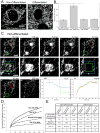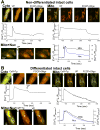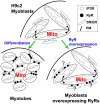Switch from ER-mitochondrial to SR-mitochondrial calcium coupling during muscle differentiation
- PMID: 22784666
- PMCID: PMC3607359
- DOI: 10.1016/j.ceca.2012.05.012
Switch from ER-mitochondrial to SR-mitochondrial calcium coupling during muscle differentiation
Abstract
Emerging evidence indicates that mitochondria are locally coupled to endoplasmic reticulum (ER) Ca2+ release in myoblasts and to sarcoplasmic reticulum (SR) Ca2+ release in differentiated muscle fibers in order to regulate cytoplasmic calcium dynamics and match metabolism with cell activity. However, the mechanism of the developmental transition from ER to SR coupling remains unclear. We have studied mitochondrial sensing of IP3 receptor (IP3R)- and ryanodine receptor (RyR)-mediated Ca2+ signals in H9c2 myoblasts and differentiating myotubes, as well as the attendant changes in mitochondrial morphology. Mitochondria in myoblasts were largely elongated, luminally connected and relatively few in number, whereas the myotubes were densely packed with globular mitochondria that displayed limited luminal continuity. Vasopressin, an IP3-linked agonist, evoked a large cytoplasmic Ca2+ ([Ca2+]c) increase in myoblasts, whereas it elicited a smaller response in myotubes. Conversely, RyR-mediated Ca2+ release induced by caffeine, was not observed in myoblasts, but triggered a large [Ca2+]c signal in myotubes. Both the IP3R and the RyR-mediated [Ca2+]c rise was closely associated with a mitochondrial matrix Ca2+ ([Ca2+]m) signal. Every myotube that showed a [Ca2+]c spike also displayed a [Ca2+]m response. Addition of IP3 to permeabilized myoblasts and caffeine to permeabilized myotubes also resulted in a rapid [Ca2+]m rise, indicating that Ca2+ was delivered via local coupling of the ER/SR and mitochondria. Thus, as RyRs are expressed during muscle differentiation, the local connection between RyR and mitochondrial Ca2+ uptake sites also appears. When RyR1 was exogenously introduced to myoblasts by overexpression, the [Ca2+]m signal appeared together with the [Ca2+]c signal, however the mitochondrial morphology remained unchanged. Thus, RyR expression alone is sufficient to induce the steps essential for their alignment with mitochondrial Ca2+ uptake sites, whereas the mitochondrial proliferation and reshaping utilize either downstream or alternative pathways.
Copyright © 2012 Elsevier Ltd. All rights reserved.
Figures






Similar articles
-
Quantification of calcium signal transmission from sarco-endoplasmic reticulum to the mitochondria.J Physiol. 2000 Dec 15;529 Pt 3(Pt 3):553-64. doi: 10.1111/j.1469-7793.2000.00553.x. J Physiol. 2000. PMID: 11118489 Free PMC article.
-
Inositol 1,4,5-trisphosphate-mediated sarcoplasmic reticulum-mitochondrial crosstalk influences adenosine triphosphate production via mitochondrial Ca2+ uptake through the mitochondrial ryanodine receptor in cardiac myocytes.Cardiovasc Res. 2016 Oct;112(1):491-501. doi: 10.1093/cvr/cvw185. Epub 2016 Aug 5. Cardiovasc Res. 2016. PMID: 27496868 Free PMC article.
-
Overexpression of ryanodine receptor type 1 enhances mitochondrial fragmentation and Ca2+-induced ATP production in cardiac H9c2 myoblasts.Am J Physiol Heart Circ Physiol. 2013 Dec;305(12):H1736-51. doi: 10.1152/ajpheart.00094.2013. Epub 2013 Oct 11. Am J Physiol Heart Circ Physiol. 2013. PMID: 24124188 Free PMC article.
-
Ca2+ stores regulate ryanodine receptor Ca2+ release channels via luminal and cytosolic Ca2+ sites.Clin Exp Pharmacol Physiol. 2007 Sep;34(9):889-96. doi: 10.1111/j.1440-1681.2007.04708.x. Clin Exp Pharmacol Physiol. 2007. PMID: 17645636 Review.
-
Sarco-Endoplasmic Reticulum Calcium Release Model Based on Changes in the Luminal Calcium Content.Adv Exp Med Biol. 2020;1131:337-370. doi: 10.1007/978-3-030-12457-1_14. Adv Exp Med Biol. 2020. PMID: 31646517 Review.
Cited by
-
Role of nociceptor αCaMKII in transition from acute to chronic pain (hyperalgesic priming) in male and female rats.J Neurosci. 2013 Jul 3;33(27):11002-11. doi: 10.1523/JNEUROSCI.1785-13.2013. J Neurosci. 2013. PMID: 23825405 Free PMC article.
-
Inositol trisphosphate receptor-mediated Ca2+ signalling stimulates mitochondrial function and gene expression in core myopathy patients.Hum Mol Genet. 2018 Jul 1;27(13):2367-2382. doi: 10.1093/hmg/ddy149. Hum Mol Genet. 2018. PMID: 29701772 Free PMC article.
-
Analysis of mitochondrial structure and function in the Drosophila larval musculature.Mitochondrion. 2016 Jan;26:33-42. doi: 10.1016/j.mito.2015.11.005. Epub 2015 Dec 1. Mitochondrion. 2016. PMID: 26611999 Free PMC article. Review.
-
Calcium and Reactive Oxygen Species Signaling Interplays in Cardiac Physiology and Pathologies.Antioxidants (Basel). 2023 Feb 2;12(2):353. doi: 10.3390/antiox12020353. Antioxidants (Basel). 2023. PMID: 36829912 Free PMC article. Review.
-
Simultaneous Measurement of Changes in Mitochondrial and Endoplasmic Reticulum Free Calcium in Pancreatic Beta Cells.Biosensors (Basel). 2023 Mar 14;13(3):382. doi: 10.3390/bios13030382. Biosensors (Basel). 2023. PMID: 36979594 Free PMC article.
References
-
- Rusinol AE, Cui Z, Chen MH, Vance JE. A unique mitochondria-associated membrane fraction from rat liver has a high capacity for lipid synthesis and contains pre-Golgi secretory proteins including nascent lipoproteins. J Biol Chem. 1994;269:27494–502. - PubMed
-
- Rizzuto R, Pinton P, Carrington W, Fay FS, Fogarty KE, Lifshitz LM, Tuft RA, Pozzan T. Close contacts with the endoplasmic reticulum as determinants of mitochondrial Ca2+ responses. Science. 1998;280:1763–6. - PubMed
-
- de Brito OM, Scorrano L. Mitofusin 2 tethers endoplasmic reticulum to mitochondria. Nature. 2008;456:605–10. - PubMed
Publication types
MeSH terms
Substances
Grants and funding
LinkOut - more resources
Full Text Sources
Research Materials
Miscellaneous

